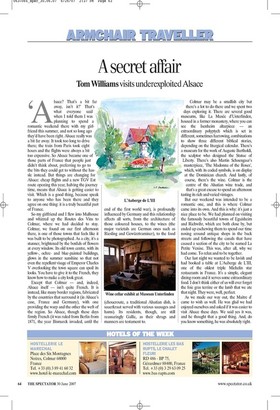A secret affair
Tom Williams visits underexploited Alsace 'A lsace? That's a bit far away, isn't it?' That's what everyone said when I told them I was planning to spend a romantic weekend there with my girlfriend this summer, and not so long ago they'd have been right. Alsace really was a bit far away. It took too long to drive there; the train from Paris took eight hours and the flights were always a bit too expensive. So Alsace became one of those parts of France that people just didn't think about, preferring to go to the bits they could get to without the hassle instead. But things are changing for Alsace: cheap flights and a new TGV Est route opening this year, halving the journey time, means that Alsace is getting easier to visit. Which is a good thing, because speak to anyone who has been there and they agree on one thing: it is a truly beautiful part of France.
So my girlfriend and I flew into Mulhouse and whizzed up the Routes des Vins to Colmar, where we had decided to stay. Colmar, we found on our first afternoon there, is one of those towns that feels like it was built to be photographed. As a city, it's a stunner, brightened by the boxfuls of flowers at every window. Its old town centre, with its yellow-, ochreand blue-painted buildings, glows in the summer sunshine so that not even the repellent visage of Emperor Charles V overlooking the town square can spoil its looks. You have to give it to the French, they know how to make a city look great.
Except that Colmar — and, indeed, Alsace itself — isn't quite French. It is instead, like many border regions, fabricated by the countries that surround it (in Alsace's case, France and Germany), with one providing the warp and the other the weft of the region. So Alsace, though these days firmly French (it was ruled from Berlin from 1871, the year Bismarck invaded, until the end of the first world war), is profoundly influenced by Germany and this relationship affects all sorts, from the architecture of those coloured houses, to the wines (the major varietals are German ones such as Riesling and Gewarztraminer), to the food (choucroute, a traditional Alsatian dish, is sauerkraut served with various sausages and hams). Its residents, though, are still reassuringly Gallic, as their shrugs and manners are testament to.
Colmar may be a smallish city but there's a lot to do there and we spent two days exploring it. There are several good museums, like La Musee d'Unterlinden, housed in a former monastery, where you can see the Isenheim altarpiece — an extraordinary polyptych which is set in different, sometimes harrowing, combinations to show three different biblical stories, depending on the liturgical calendar. There's a museum for the work of Auguste Bartholdi, the sculptor who designed the Statue of Liberty. There's also Martin Schoengaur's masterpiece, 'The Madonna of the Roses', which, with its coded symbols, is on display at the Dominican church. And lastly, of course, there's the wine. Colmar is the centre of the Alsatian wine trade, and that's a great excuse to spend an afternoon tasting its rich and varied vintages.
But our weekend was intended to be a romantic one, and this is where Colmar came into its own. And this is why: it's just a nice place to be. We had planned on visiting the famously beautiful towns of Eguisheim and Richwihr, which are both close by, but ended up eschewing them to spend our time nosing around antique shops in the back streets and following the canals that have caused a section of the city to be named La Petite Venise. This was, after all, why we had come. To relax and to be together.
Our last night we wanted to be lavish and had booked a table at L'Auberge de L'III, one of the oldest triple Michelin star restaurants in France. It's a simple, elegant dining-room and it serves some extraordinary food. I don't think either of us will ever forget the foie gras terrine or the lamb that we ate that night. They were, well, perfect.
As we made our way out, the Maitre d' came to wish us well. He was glad we had enjoyed ourselves and asked if it was easier to visit Alsace these days. We said yes it was, and he thought that a good thing. And, do you know something, he was absolutely right.


















































































 Previous page
Previous page